Seleucid dynasty
Royal family of the Seleucid Empire From Wikipedia, the free encyclopedia
The Seleucid dynasty or the Seleucidae (/sɪˈluːsɪˌdiː/; Greek: Σελευκίδαι, Seleukídai, "descendants of Seleucus") was a Macedonian Greek royal family, which ruled the Seleucid Empire based in West Asia during the Hellenistic period. It was founded by Seleucus I Nicator, a general and successor of Alexander the Great, after the division of the Macedonian Empire as a result of the Wars of the Successors (Diadochi).
| Seleucids Σελευκίδαι | |
|---|---|
| 312 BC – 64 BC Royal house | |
 The Vergina Sun remained a principal standard of the Seleucid dynasty, although the anchor and elephant were more prevalent. | |
| Country | Syria, Persia |
| Founded | 312 BC |
| Founder | Seleucus I |
| Final ruler | Philip II Philoromaeus |
| Titles | |
| Dissolution | 64 BC |
| Cadet branches | Diodotid dynasty (Bactria)(?) |
Through its history, the Seleucid dominion included large parts of the Near East, as well as of the Asian territory of the earlier Achaemenid Persian Empire. A major center of Hellenistic culture, it attracted a large number of immigrants from Greece who, encouraged by the Seleucids, formed a dominant political elite under the ruling dynasty.[1] After the death of Seleucus I, his successors maintained the empire's strength establishing it as a Greek power in West Asia;[2] the empire reached its height under emperor Antiochus III.[3] From the mid-second century BC, after its defeat at the hands of the resurgent Parthian Empire, the polity entered a state of instability with slow territorial losses and internecine civil wars. The Seleucids, now reduced to a rump state occupying a small part of Syria succumbed to the Rome's annexation of their territory in 64 BC under Pompey the Great.
History
Background
Seleucus (c. 358 – 281 BC) served as an officer of Alexander the Great, commanding the elite infantry corps in the Macedonian army: the "Shield-bearers" (Greek: Ὑπασπισταί, Hypaspistai), later known as the "Silvershields" (Ἀργυράσπιδες, Argyraspides).[4] After the death of Alexander in 323 BC, the Partition of Triparadisus assigned Seleucus as satrap of Babylon in 321 BC.[5] Antigonus, the satrap of much of Asia Minor, forced Seleucus to flee from Babylon, but, supported by Ptolemy, the Satrap of Egypt, Seleucus returned in 312 BC.[6] Seleucus' later conquests included Persia and Media. He agreed to a peace treaty with the Indian King Chandragupta Maurya (reigned 324-297 BC).[7] Seleucus defeated Antigonus in the Battle of Ipsus in 301 BC and Lysimachus (King of Thrace, Macedon and Asia Minor) in the battle of Corupedium (near Sardis) in 281 BC.[8][6] Ptolemy Ceraunus assassinated Seleucus later in the same year. Seleucus' eldest son Antiochus I succeeded him as ruler of the Seleucid territories in 281 BC.
Seleucid rulers
| Portrait | King | Reign (BC) | Consort(s) | Comments |
|---|---|---|---|---|
 | Seleucus I Nicator | Satrap 320–315, 312–305 BC King 305–281 BC | Apama | |
 | Antiochus I Soter | co-ruler from 291, ruled 281–261 BC | Stratonice of Syria | Co-ruler with his father for 10 years. |
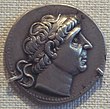 | Antiochus II Theos | 261–246 BC | Berenice was a daughter of Ptolemy II of Egypt. Laodice I had her and her son murdered. | |
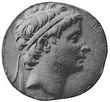 | Seleucus II Callinicus | 246–225 BC | Laodice II | Brother of Antiochus Hierax |
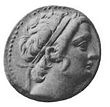 | Seleucus III Ceraunus (or Soter) | 225–223 BC | Seleucus III was assassinated by members of his army. | |
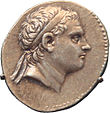 | Antiochus III the Great | 223–187 BC |
| Antiochus III was a brother of Seleucus III. |
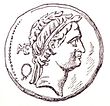 | Seleucus IV Philopator | 187–175 BC | Laodice IV | This was a brother-sister marriage. |
 | Antiochus (son of Seleucus IV) | 175–170 BC | Antiochus IV as co-ruler. | |
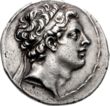 | Antiochus IV Epiphanes | 175–164 BC | Laodice IV | This was a brother-sister marriage. |
 | Antiochus V Eupator | 164–162 BC | Son of Antiochus IV and Laodice IV | |
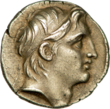 | Demetrius I Soter | 162–150 BC |
| Son of Seleucus IV Philopator and Laodice IV. |
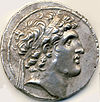 | Alexander I Balas | 150–145 BC | Cleopatra Thea | Son of Antiochus IV and Laodice IV. |
 | Demetrius II Nicator | first reign, 145–138 BC | Cleopatra Thea | Son of Demetrius I. |
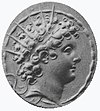 | Antiochus VI Dionysus (or Epiphanes) | 145/144–142/141 BC? | Son of Alexander Balas and Cleopatra Thea. | |
 | Diodotus Tryphon | 142/141–138 BC | General who was a regent for Antiochus VI Dionysus. Took the throne after murdering his charge. | |
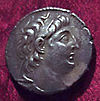 | Antiochus VII Sidetes (or Euergetes) | 138–129 BC | Cleopatra Thea | Son of Demetrius I. |
 | Demetrius II Nicator | second reign, 129–125 BC | Cleopatra Thea | Demetrius was murdered at the instigation of his wife Cleopatra Thea. |
 | Alexander II Zabinas | 128–123 BC | Counter-king who claimed to be an adoptive son of Antiochus VII Sidetes. | |
 | Cleopatra Thea | 125–121 BC | Daughter of Ptolemy VI of Egypt. Married to three kings: Alexander Balas, Demetrius II Nicator, and Antiochus VII Sidetes. Mother of Antiochus VI, Seleucus V, Antiochus VIII Grypus, and Antiochus IX Cyzicenus. Coregent with Antiochus VIII Grypus. | |
| Seleucus V Philometor | 126/125 BC | Murdered by his mother Cleopatra Thea. | ||
 | Antiochus VIII Grypus | 125–96 BC |
| |
 | Antiochus IX Cyzicenus | 116/113–95 BC | ||
 | Seleucus VI Epiphanes Nicator | 96–94 BC | ||
 | Antiochus X Eusebes Philopator | 95–92 BC or 95-88 BC | Cleopatra Selene I | |
 | Demetrius III Eucaerus (or Philopator) | 96–87 BC | ||
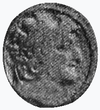 | Antiochus XI Epiphanes Philadelphus | 94–93 BC | ||
 | Philip I Philadelphus | 94–75 BC or 94-83 BC | ||
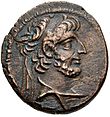 | Antiochus XII Dionysus | 87–82 BC | ||
| Cleopatra Selene or Seleucus VII | 82–69 BC | |||
 | Antiochus XIII Asiaticus | 82–64 BC | ||
| Philip II Philoromaeus | 65–64 BC or 69-64 BC (Died Possibly c.56 BC) |
Family tree
| Detailed Seleucid dynasty Family tree | |||||||||||||||||||||||||||||||||||||||||||||||||||||||||||||||||||||||||||||||||||||||||||||||||||||||||||||||||||||||||||||||||||||||||||||||||||||||||||||||||||||||||||||||||||||||||||||||||||||||||||||||||||||||||||||||||||||||||||||||||||||||||||||||||||||||||||||||||||||||||||||||||||||||||||||||||||||||||||||||||||||||||||||||||||||||||||||||||||||||||||||||||||||||||||||||||||||||||||||||||||||||||||||||||||||||||||||||||||||||||||||||||||||||||||||||||||||||||||||||||||||||||||||||||||||||||||||||||||||||||||||||||||||||||||||||||||||||||||||||||||||||||||||||||||||||||||||||||||||||||||||||||||||||||||||||||||||||||||||||||||||||||||||||||||||||||||||||||||||||||||||||||||||||||||||||||||||||||||||||||||||||||||||||||||||||||||||||||||||||||||||||||||||||||||||||||||||||||||||||||||||||||||||||||||||||||||||||||||||||||||||||||||||||||||||||||||||||||||||||||||||||||||||||||||||||||||||||||||||||||||||||||||||||||||||||||||||||||||||||||||||||||||||||||||||||||||||||||||||||
|---|---|---|---|---|---|---|---|---|---|---|---|---|---|---|---|---|---|---|---|---|---|---|---|---|---|---|---|---|---|---|---|---|---|---|---|---|---|---|---|---|---|---|---|---|---|---|---|---|---|---|---|---|---|---|---|---|---|---|---|---|---|---|---|---|---|---|---|---|---|---|---|---|---|---|---|---|---|---|---|---|---|---|---|---|---|---|---|---|---|---|---|---|---|---|---|---|---|---|---|---|---|---|---|---|---|---|---|---|---|---|---|---|---|---|---|---|---|---|---|---|---|---|---|---|---|---|---|---|---|---|---|---|---|---|---|---|---|---|---|---|---|---|---|---|---|---|---|---|---|---|---|---|---|---|---|---|---|---|---|---|---|---|---|---|---|---|---|---|---|---|---|---|---|---|---|---|---|---|---|---|---|---|---|---|---|---|---|---|---|---|---|---|---|---|---|---|---|---|---|---|---|---|---|---|---|---|---|---|---|---|---|---|---|---|---|---|---|---|---|---|---|---|---|---|---|---|---|---|---|---|---|---|---|---|---|---|---|---|---|---|---|---|---|---|---|---|---|---|---|---|---|---|---|---|---|---|---|---|---|---|---|---|---|---|---|---|---|---|---|---|---|---|---|---|---|---|---|---|---|---|---|---|---|---|---|---|---|---|---|---|---|---|---|---|---|---|---|---|---|---|---|---|---|---|---|---|---|---|---|---|---|---|---|---|---|---|---|---|---|---|---|---|---|---|---|---|---|---|---|---|---|---|---|---|---|---|---|---|---|---|---|---|---|---|---|---|---|---|---|---|---|---|---|---|---|---|---|---|---|---|---|---|---|---|---|---|---|---|---|---|---|---|---|---|---|---|---|---|---|---|---|---|---|---|---|---|---|---|---|---|---|---|---|---|---|---|---|---|---|---|---|---|---|---|---|---|---|---|---|---|---|---|---|---|---|---|---|---|---|---|---|---|---|---|---|---|---|---|---|---|---|---|---|---|---|---|---|---|---|---|---|---|---|---|---|---|---|---|---|---|---|---|---|---|---|---|---|---|---|---|---|---|---|---|---|---|---|---|---|---|---|---|---|---|---|---|---|---|---|---|---|---|---|---|---|---|---|---|---|---|---|---|---|---|---|---|---|---|---|---|---|---|---|---|---|---|---|---|---|---|---|---|---|---|---|---|---|---|---|---|---|---|---|---|---|---|---|---|---|---|---|---|---|---|---|---|---|---|---|---|---|---|---|---|---|---|---|---|---|---|---|---|---|---|---|---|---|---|---|---|---|---|---|---|---|---|---|---|---|---|---|---|---|---|---|---|---|---|---|---|---|---|---|---|---|---|---|---|---|---|---|---|---|---|---|---|---|---|---|---|---|---|---|---|---|---|---|---|---|---|---|---|---|---|---|---|---|---|---|---|---|---|---|---|---|---|---|---|---|---|---|---|---|---|---|---|---|---|---|---|---|---|---|---|---|---|---|---|---|---|---|---|---|---|---|---|---|---|---|---|---|---|---|---|---|---|---|---|---|---|---|---|---|---|---|---|---|---|---|---|---|---|---|---|---|---|---|---|---|---|---|---|---|---|---|---|---|---|---|---|---|---|---|---|---|---|---|---|---|---|---|---|---|---|---|---|---|---|---|---|---|---|---|---|---|---|---|---|---|---|---|---|---|---|---|---|---|---|---|---|---|---|---|---|---|---|---|---|---|---|---|---|---|---|---|---|---|---|---|---|---|---|---|---|---|---|---|---|---|---|---|---|---|---|---|---|---|---|---|---|---|---|---|---|---|---|---|---|---|---|---|---|---|---|---|---|---|---|---|---|---|---|---|---|---|---|---|---|---|---|---|---|---|---|---|---|---|---|---|---|---|---|---|---|---|---|---|---|---|---|---|---|---|---|---|---|---|---|---|---|---|---|---|---|---|---|---|---|---|---|---|---|---|---|---|---|---|---|---|---|---|---|---|---|---|---|---|---|---|---|---|---|---|---|---|---|---|---|---|---|---|---|---|---|---|---|---|---|---|---|---|---|---|---|---|---|---|---|---|---|---|---|---|---|---|---|---|---|---|---|---|---|---|---|---|---|---|---|---|---|---|---|---|---|---|---|---|---|---|---|---|---|---|---|---|---|---|---|---|---|---|---|---|---|---|---|---|---|---|---|---|---|---|---|---|---|---|---|---|---|---|---|---|---|---|---|---|---|---|---|---|---|---|---|---|---|---|---|---|---|---|---|---|---|---|---|---|---|---|---|---|---|---|---|---|---|---|---|---|
| |||||||||||||||||||||||||||||||||||||||||||||||||||||||||||||||||||||||||||||||||||||||||||||||||||||||||||||||||||||||||||||||||||||||||||||||||||||||||||||||||||||||||||||||||||||||||||||||||||||||||||||||||||||||||||||||||||||||||||||||||||||||||||||||||||||||||||||||||||||||||||||||||||||||||||||||||||||||||||||||||||||||||||||||||||||||||||||||||||||||||||||||||||||||||||||||||||||||||||||||||||||||||||||||||||||||||||||||||||||||||||||||||||||||||||||||||||||||||||||||||||||||||||||||||||||||||||||||||||||||||||||||||||||||||||||||||||||||||||||||||||||||||||||||||||||||||||||||||||||||||||||||||||||||||||||||||||||||||||||||||||||||||||||||||||||||||||||||||||||||||||||||||||||||||||||||||||||||||||||||||||||||||||||||||||||||||||||||||||||||||||||||||||||||||||||||||||||||||||||||||||||||||||||||||||||||||||||||||||||||||||||||||||||||||||||||||||||||||||||||||||||||||||||||||||||||||||||||||||||||||||||||||||||||||||||||||||||||||||||||||||||||||||||||||||||||||||||||||||||||
See also
Footnotes
External links
Wikiwand - on
Seamless Wikipedia browsing. On steroids.
